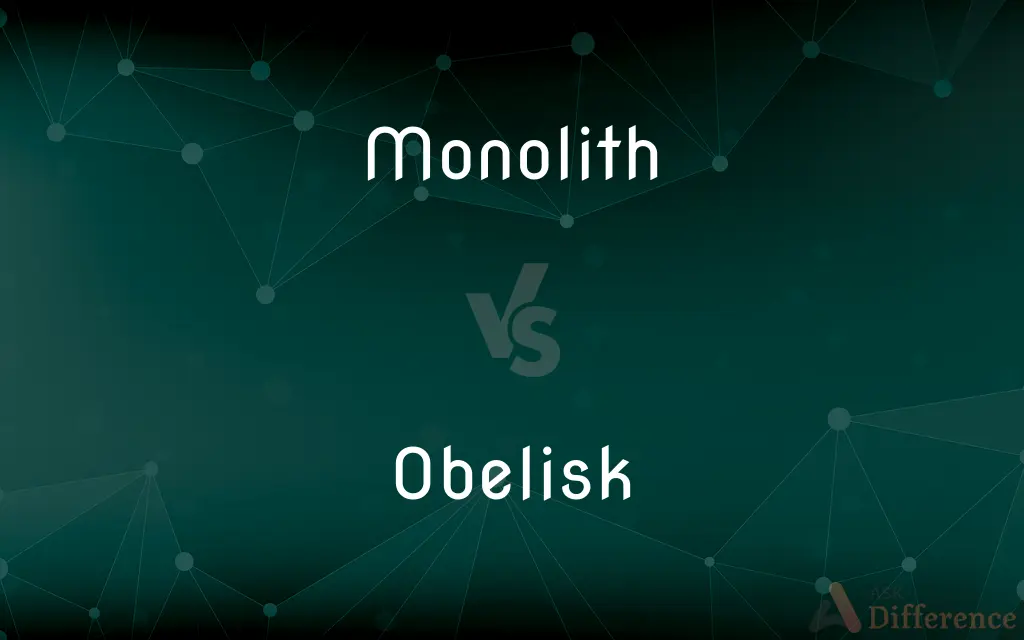Monolith vs. Obelisk — What's the Difference?
By Tayyaba Rehman — Updated on August 5, 2024
A monolith is a large, single block of stone, used in architecture or sculpture, often unshaped or only roughly shaped, whereas an obelisk is a tall, four-sided, narrow, tapering monument which ends in a pyramid-like shape at the top.

Difference Between Monolith and Obelisk
Table of Contents
ADVERTISEMENT
Key Differences
Monolith and obelisk are terms often used to describe architectural and sculptural structures, primarily differentiated by their shape and function. A monolith is typically a large, single piece of rock or stone, sometimes standing alone or as part of a larger structure, and can be unshaped or only roughly shaped. It serves as a representation of architectural grandiosity and historical significance. In contrast, an obelisk is a stone pillar, typically having a rectangular or square cross-section, with a pyramidal top. It is designed to commemorate individuals or events and is often inscribed with hieroglyphs or other types of inscriptions.
In terms of structure, monoliths exhibit diversity, varying from natural geological features to large, cut stones used in construction, while obelisks have a more standardized, geometric form, characterized by their tall, slender, and tapering profile ending in a small pyramidion. Monoliths can be monumental and unworked, depicting the raw beauty of natural stone, whereas obelisks, through their inscriptions and structured form, often narrate tales of historical or cultural significance.
The functional intent behind monoliths and obelisks also varies. Monoliths can be used both as structural elements in construction or as standalone monuments. Their simplistic, bold presence often makes them symbolic of endurance and timelessness. On the other hand, obelisks primarily serve as commemorative monuments, their inscriptions preserving the legacies and stories of the past, acting as historical markers providing insights into the civilizations that erected them.
The aesthetic appeal of monoliths and obelisks is another differentiating factor. Monoliths, with their unrefined and rugged appeal, evoke a sense of awe and reverence, symbolizing the enduring strength of nature. Conversely, obelisks, with their precise geometry and intricate inscriptions, reflect human ingenuity and craftsmanship, serving as artistic representations of cultural heritage and human achievement.
To sum up, while both monoliths and obelisks are prominent stone structures, they differ in their shape, function, aesthetic appeal, and the stories they convey. Monoliths, often rough and unshaped, symbolize endurance and timelessness, whereas obelisks, with their slender, tapering forms and inscriptions, serve as commemorative monuments reflecting human craftsmanship and cultural heritage.
ADVERTISEMENT
Comparison Chart
Definition
A large, single block of stone, either shaped or unshaped
A tall, four-sided, tapering monument with a pyramidal top
Structure & Form
Can be irregular and varied, can be part of larger structures
Standardized, geometric, slender, and tapering
Function & Intent
Serves as structural elements or standalone monuments
Primarily commemorative, erected to honor individuals or events
Aesthetic & Appeal
Exhibits raw and natural beauty, symbolizing endurance
Reflects precision and craftsmanship, represents cultural heritage
Inscription & Detailing
Usually lacks inscriptions and detailed carvings
Often features inscriptions or hieroglyphs, detailing historical events or individuals
Compare with Definitions
Monolith
A geological feature consisting of a single massive stone or rock.
The monolith rose majestically from the desert sands, a testament to nature's grandiosity.
Obelisk
A stone pillar, typically having a square or rectangular cross-section, set up as a monument or landmark.
The ancient obelisk was covered in hieroglyphs, each telling a different story of the past.
Monolith
A large, single piece of stone, often unworked or only roughly worked.
The ancient monolith stood as a silent witness to the civilizations that once flourished around it.
Obelisk
A freestanding pillar, often monolithic, marked by its uniformly tapering form and a pyramidal apex.
The gleaming obelisk was a beacon of remembrance, honoring those who had come before.
Monolith
A singular stone structure, symbolizing unity and timelessness.
The citizens gathered around the monolith, celebrating the unity it represented.
Obelisk
A tall, four-sided, narrow tapering monument which ends in a pyramid-like shape at the top.
The obelisk stood in the city square, inscribed with the names of the war heroes.
Monolith
A monolith is a geological feature consisting of a single massive stone or rock, such as some mountains. Erosion usually exposes the geological formations, which are often made of very hard and solid igneous or metamorphic rock.
Obelisk
A slender, upright monument, engraved with inscriptions or hieroglyphs.
The shadows of the obelisk danced on the ground as the sun traversed the sky.
Monolith
A large single upright block of stone, especially one shaped into or serving as a pillar or monument
We passed Stonehenge, the strange stone monoliths silhouetted against the horizon
Obelisk
An obelisk (; from Ancient Greek: ὀβελίσκος obeliskos; diminutive of ὀβελός obelos, "spit, nail, pointed pillar") is a tall, four-sided, narrow tapering monument which ends in a pyramid-like shape or pyramidion at the top. Originally they were called tekhenu by their builders, the Ancient Egyptians.
Monolith
A large, impersonal political, corporate, or social structure regarded as indivisible and slow to change
Independent voices have been crowded out by the media monoliths
Obelisk
A tall, four-sided shaft of stone, usually tapered and monolithic, that rises to a pointed pyramidal top.
Monolith
A large block of stone, especially one used in architecture or sculpture.
Obelisk
The dagger sign (†), used especially as a reference mark. Also called dagger, obelus.
Monolith
Something, such as a column or monument, made from one large block of stone.
Obelisk
(architecture) A tall, square, tapered, stone monolith topped with a pyramidal point, frequently used as a monument.
Monolith
An outcropping, cliff, or mountain having the appearance of a single block of stone
"On a waterway of grand pilot marks, the finest lay just ahead, Beacon Rock, a distinctive black monolith some eight hundred feet high" (William Least Heat-Moon).
Obelisk
(typography) obelus
Monolith
Something suggestive of a large block of stone, as in immovability, massiveness, or uniformity
"Standing against a global Communism it took to be monolithic, the Pentagon wanted to be taken as a monolith" (William Carroll).
Obelisk
(historical) A symbol resembling a horizontal line (–), sometimes together with one or two dots (for example, ⨪ or ÷), which was used in ancient manuscripts and texts to mark a word or passage as doubtful or spurious, or redundant.
Monolith
A large, single block of stone which is a natural feature; or a block of stone or other similar material used in architecture and sculpture, especially one carved into a monument in ancient times.
Obelisk
A dagger symbol (†), which is used in printed matter as a reference mark to refer the reader to a footnote, marginal note, etc.; beside a person's name to indicate that the person is deceased; or beside a date to indicate that it is a person's death date.
Monolith
Anything massive, uniform, and unmovable, especially a towering and impersonal cultural, political, or social organization or structure.
Obelisk
To adopt the obelisk posture; to point the tip of the abdomen towards the sun.
Monolith
(chemistry) A substrate having many tiny channels that is cast as a single piece, which is used as a stationary phase for chromatography, as a catalytic surface, etc.
Obelisk
An upright, four-sided pillar, gradually tapering as it rises, and terminating in a pyramid called pyramidion. It is ordinarily monolithic. Egyptian obelisks are commonly covered with hieroglyphic writing from top to bottom.
Monolith
A dead tree whose height and size have been reduced by breaking off or cutting its branches.
Obelisk
To mark or designate with an obelisk.
Monolith
(transitive) To create (something) as, or convert (one or more things) into, a monolith.
Obelisk
A stone pillar having a rectangular cross section tapering towards a pyramidal top
Monolith
(construction) To cast (one or more concrete components) in a single piece with no joints.
Obelisk
A character used in printing to indicate a cross reference or footnote
Monolith
To reduce the height and size of (a dead tree) by breaking off or cutting its branches.
Obelisk
A geometric structure, often used to commemorate individuals or historical events.
Historians studied the obelisk to glean insights into the civilization that created it.
Monolith
A single stone, especially one of large size, shaped into a pillar, statue, or monument.
Monolith
A single great stone (often in the form of a column or obelisk)
Monolith
A monumental structure carved or formed from a single block of stone.
The artisans meticulously carved the intricate designs into the monolith, bringing the stone to life.
Monolith
An unbroken, large piece of stone used as a monument or building material.
The engineers marveled at the sheer size of the monolith, contemplating its incorporation into the new building.
Common Curiosities
Is a monolith always made of stone?
Typically, yes. A monolith is traditionally a large, single block of stone, although the term can metaphorically refer to something large and unyielding.
Do obelisks always have a pyramidal top?
Traditionally, yes. Obelisks usually taper to a pyramid-like shape at the top, called a pyramidion.
Can a monolith be man-made?
Yes. While many are natural, monoliths can also be man-made, carved, or shaped for specific purposes, such as monuments or structures.
Are obelisks found only in Egypt?
While associated with ancient Egypt, obelisks are found worldwide, symbolizing power and commemorating individuals or events in various cultures.
Is every obelisk also a monolith?
Many obelisks are monoliths if carved from a single piece of stone, but not all, as some may be constructed from several blocks.
Is the Washington Monument an obelisk?
Yes, the Washington Monument is an example of a modern obelisk.
Do obelisks have a religious significance?
In many cultures, yes. Obelisks often have religious or spiritual significance and may be associated with burial or worship practices.
Can the term “monolith” refer to something metaphorical?
Yes, “monolith” can metaphorically refer to something large, unyielding, and indivisible, such as an organization.
Are obelisks exclusively outdoor structures?
Traditionally, yes, as they are monumental structures, but miniature decorative obelisks can also be found indoors.
Can monoliths be found in nature?
Yes, many monoliths are natural geological features, formed from single, large blocks of stone.
Can a monolith have inscriptions?
While traditionally more unshaped and unworked, some monoliths can indeed have inscriptions or carvings.
Are monoliths and obelisks always monumental in size?
Often, but not always. Both can vary in size, but they are typically large and imposing to serve their commemorative or symbolic purposes.
Do monoliths serve a practical purpose?
Monoliths can serve practical purposes, such as being structural elements in construction, in addition to their symbolic or aesthetic roles.
Can an obelisk be made from materials other than stone?
Traditionally made of stone, modern obelisks can be made from a variety of materials, including metal and concrete.
Share Your Discovery

Previous Comparison
Physician vs. Physiotherapist
Next Comparison
Inhalation vs. InspirationAuthor Spotlight
Written by
Tayyaba RehmanTayyaba Rehman is a distinguished writer, currently serving as a primary contributor to askdifference.com. As a researcher in semantics and etymology, Tayyaba's passion for the complexity of languages and their distinctions has found a perfect home on the platform. Tayyaba delves into the intricacies of language, distinguishing between commonly confused words and phrases, thereby providing clarity for readers worldwide.













































